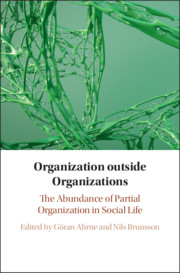Book contents
- Organization outside Organizations
- Organization outside Organizations
- Copyright page
- Contents
- Preface
- Contributors
- Introduction
- Part 1 Rules, Sanctions, Membership
- Part 2 Organization in and around Markets
- Part 3 Networks and Other Social Relationships
- 9 The Inter-Firm Network as Partial Organization?
- 10 An Organized Network: World Economic Forum and the Partial Organizing of Global Agendas
- 11 Organizing Intimacy
- 12 How Is ‘Organized Crime’ Organized?
- 13 Brotherhood as an Organized Social Relationship
- Part 4 Social Movements and Collective Action
- Part 5 The Partial Organization of Formal Organizations
- Conclusion
- Index
- References
9 - The Inter-Firm Network as Partial Organization?
from Part 3 - Networks and Other Social Relationships
Published online by Cambridge University Press: 11 July 2019
- Organization outside Organizations
- Organization outside Organizations
- Copyright page
- Contents
- Preface
- Contributors
- Introduction
- Part 1 Rules, Sanctions, Membership
- Part 2 Organization in and around Markets
- Part 3 Networks and Other Social Relationships
- 9 The Inter-Firm Network as Partial Organization?
- 10 An Organized Network: World Economic Forum and the Partial Organizing of Global Agendas
- 11 Organizing Intimacy
- 12 How Is ‘Organized Crime’ Organized?
- 13 Brotherhood as an Organized Social Relationship
- Part 4 Social Movements and Collective Action
- Part 5 The Partial Organization of Formal Organizations
- Conclusion
- Index
- References
Summary
The objective of this chapter is to explore the potential of the partial-organization concept as applied to the analysis of inter-firm networks as a form of economic governance that is created, reproduced or transformed with the help of network management practices. Key insights that the partial-organization perspective can provide into the process and the outcome of organizing and managing inter-firm networks are discussed. Inter-firm networks are conceived as partial organization of more or less complete formal organizations. Under specific circumstances, inter-firm networks could even be considered, at least in some aspects, as being even more organized than organizations. With regard to insights into the dynamics of this organizational form the chapter argues that the concept of partial organization helps to understand the development of this form from initial market relationships as well as from hierarchical organizations
Keywords
Information
- Type
- Chapter
- Information
- Organization outside OrganizationsThe Abundance of Partial Organization in Social Life, pp. 191 - 211Publisher: Cambridge University PressPrint publication year: 2019
References
Accessibility standard: Unknown
Why this information is here
This section outlines the accessibility features of this content - including support for screen readers, full keyboard navigation and high-contrast display options. This may not be relevant for you.Accessibility Information
- 5
- Cited by
